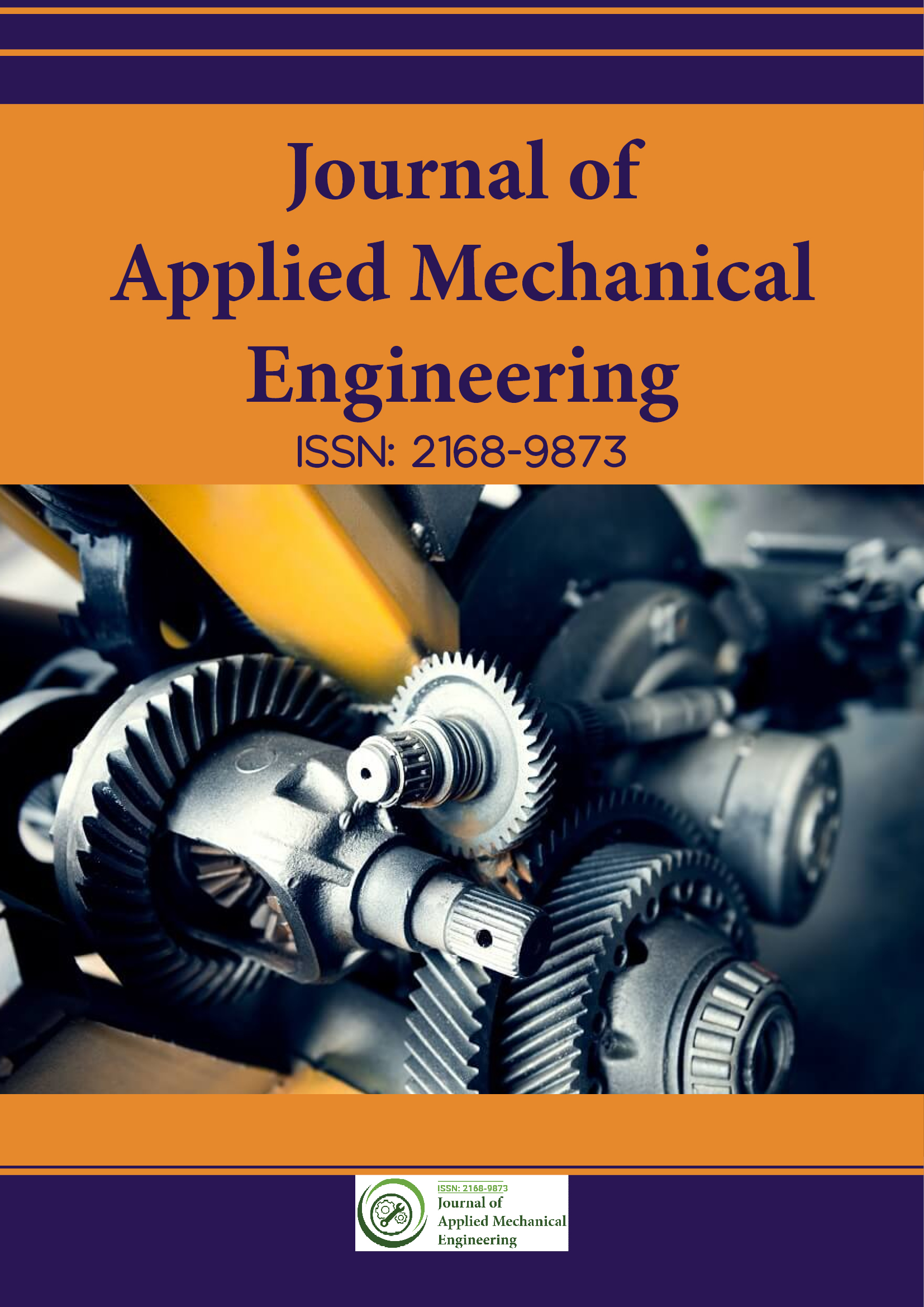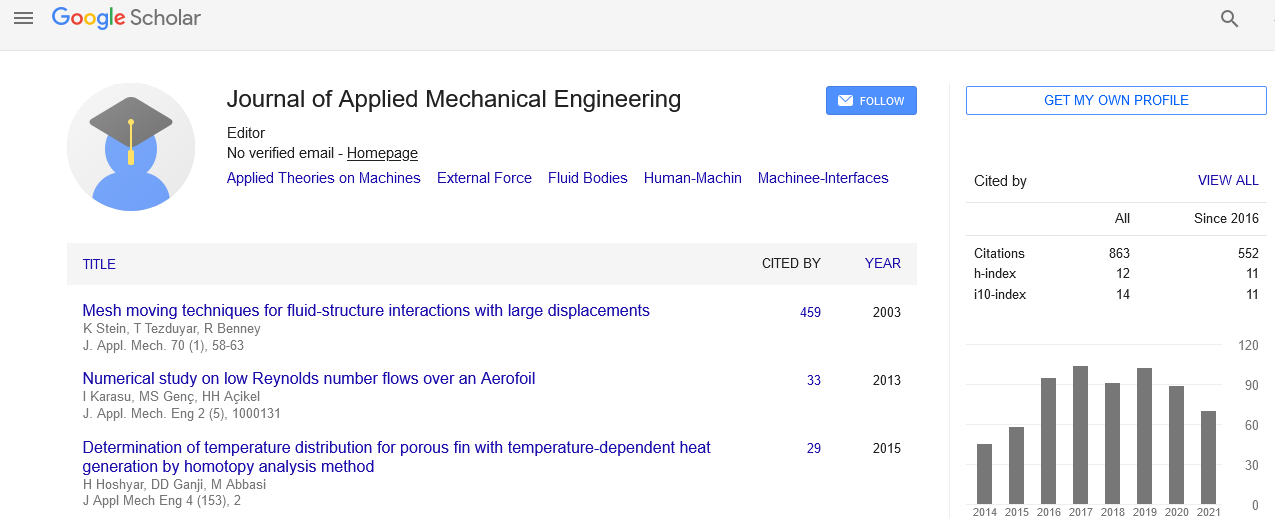Indexed In
- Genamics JournalSeek
- JournalTOCs
- CiteFactor
- RefSeek
- Hamdard University
- EBSCO A-Z
- OCLC- WorldCat
- Publons
- Google Scholar
Useful Links
Share This Page
Journal Flyer

Open Access Journals
- Agri and Aquaculture
- Biochemistry
- Bioinformatics & Systems Biology
- Business & Management
- Chemistry
- Clinical Sciences
- Engineering
- Food & Nutrition
- General Science
- Genetics & Molecular Biology
- Immunology & Microbiology
- Medical Sciences
- Neuroscience & Psychology
- Nursing & Health Care
- Pharmaceutical Sciences
Perspective - (2025) Volume 14, Issue 1
Tribology in Mechanical Engineering: Navigating the Science of Friction, Wear, and Lubrication
Lindsay Mellor*Received: 14-Nov-2023, Manuscript No. JAME-23-23912; Editor assigned: 17-Nov-2023, Pre QC No. JAME-23-23912 (PQ); Reviewed: 01-Dec-2023, QC No. JAME-23-23912; Revised: 09-Jan-2025, Manuscript No. JAME-23-23912 (R); Published: 16-Jan-2025, DOI: 10.35248/2168-9873.25.14.530
Desciption
Tribology, derived from the Greek words "tribos" (meaning rubbing) and "logos" (meaning study), stands as a cornerstone in the field of mechanical engineering. This multidisciplinary science explores the interactions between surfaces in relative motion, encompassing the study of friction, wear and lubrication. In this article, we delve into the fundamental principles, applications and significance of tribology in mechanical engineering.
Understanding tribology
Tribology addresses the complex interplay of forces and interactions that occur when two surfaces come into contact. It involves the study of friction, which resists the relative motion of surfaces; wear, which encompasses the loss of material due to surface interactions and lubrication, which seeks to minimize friction and wear by introducing a lubricant between moving surfaces.
Friction: Friction, a fundamental aspect of tribology, refers to the resistance encountered when two surfaces move or attempt to move relative to each other. Tribologists analyze the factors influencing friction, such as surface roughness, material properties and the presence of contaminants, to optimize mechanical systems for efficiency and durability.
Wear: Wear is the gradual loss of material from the surfaces in contact, a phenomenon that occurs due to the mechanical interactions, adhesion and abrasion between materials. Tribologists study wear mechanisms and develop strategies to mitigate wear, extending the lifespan of components in machinery and devices.
Lubrication: Lubrication is a key aspect of tribology aimed at reducing friction and minimizing wear by introducing a lubricant between moving surfaces. Lubricants, which can be liquids, solids, or gases, create a protective film that separates surfaces, facilitating smooth motion and preventing direct metal-to-metal contact.
Applications of tribology in mechanical engineering
Automotive engineering: Tribology plays a vital role in the automotive industry, influencing the design and performance of engines, transmissions and braking systems. Engine oils, transmission fluids and brake fluids are engineered to provide effective lubrication, minimizing friction and wear in critical components.
Bearings and gears: Bearings and gears are integral components in machinery, and tribology is paramount in their design and functionality. Proper lubrication is essential to ensure the smooth operation of bearings and gears, minimizing wear and extending their operational life in various applications, from industrial machinery to aircraft propulsion systems.
Aerospace engineering: In the aerospace sector, where precision and reliability are paramount, tribology plays a vital role. Lubrication is critical in aircraft engines, landing gear systems and control surfaces to ensure safe and efficient operation. Tribological considerations also influence the development of materials for aerospace components.
Manufacturing processes: Tribology impacts various manufacturing processes, particularly those involving metal cutting, forming and moulding. Engineers employ lubricants and coatings to enhance tool life, improve surface finish and optimize the efficiency of manufacturing operations.
Biomedical engineering: In the field of biomedical engineering, tribology is essential for the development of medical implants and prosthetics. Lubrication in joint replacements, for example, is crucial to reducing wear and ensuring the longevity and performance of implants within the human body.
Future trends and innovations
The integration of sensor technology and data analytics is paving the way for smart lubrication systems. Real-time monitoring of tribological conditions allows for predictive maintenance, optimizing lubrication strategies and extending the life of mechanical components. Nanotribology explores the interactions between surfaces at the nanoscale. Understanding and manipulating these interactions can lead to the development of advanced materials and coatings with superior tribological properties, opening new avenues for performance optimization in mechanical systems. Drawing inspiration from nature, bioinspired lubrication involves mimicking the lubrication mechanisms found in biological systems. This approach aims to develop environmentally friendly and highly efficient lubricants based on the principles observed in joints and synovial fluids in living organisms. The rise of additive manufacturing, or 3D printing, presents opportunities to design complex structures with tailored tribological properties. Engineers can experiment with innovative geometries and materials to optimize friction and wear characteristics in components.
Conclusion
Tribology, as the science of friction, wear, and lubrication, remains at the forefront of advancements in mechanical engineering. From improving the efficiency of automotive engines to extending the life of industrial machinery, tribological principles underpin the design and operation of a wide range of mechanical systems. As technology continues to progress, the integration of smart systems, nanotechnology and bio-inspired approaches will shape the future of tribology, ushering in a new era of precision, sustainability and innovation in mechanical engineering. The quest for reduced friction, minimized wear and enhanced lubrication is a journey that not only improves the performance of machines but also contributes to the sustainable and responsible evolution of engineering practices.
Citation: Mellor L (2025) Tribology in Mechanical Engineering: Navigating the Science of Friction, Wear, and Lubrication. J Appl Mech Eng. 14:530.
Copyright: © 2025 Mellor L. This is an open-access article distributed under the terms of the Creative Commons Attribution License, which permits unrestricted use, distribution, and reproduction in any medium, provided the original author and source are credited.

